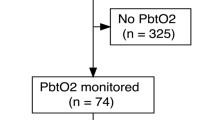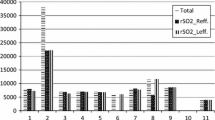Abstract
Revascularization treatments (IV thrombolysis, mechanical thrombectomy) related to ischemic stroke have developed in recent years. With devices such as NIRS, non-invasive monitoring of treatment efficacy is provided. In this study, we aimed to use near-infrared spectroscopy (NIRS) as an objective monitoring method to see the effect of intravenous (IV) thrombolysis or mechanical thrombectomy treatments applied for cerebral oxygenation in patients with acute ischemic stroke. This study was carried out as a prospective study involving patients admitted to the emergency department in the years 2021–2022. NIRS measured regional oxygen saturation (rSO2) of both hemispheres of the brain before IV thrombolysis treatment, during the treatment at 0. min, 15. min, 30. min, 45. min, 60. min, after the treatment, and before and after the mechanical thrombectomy procedure. The significance level of the change in rSO2 values measured by NIRS was examined. 80 patients were included in the study. IV thrombolysis was applied to 58 patients, mechanical thrombectomy was applied to 5 of them, and both treatments were applied to 17 of them. In patients receiving IV thrombolysis, a significant difference was found in the affected hemisphere between the NIRS values measured at 0.min–15.min, 0.min–30.min, 0.min–45.min, 0.min–60.min, 0.min-post-treatment, 15.min-60.min (p < 0.001). In the patients included in the study, there was a strong and significant negative correlation between the deltaNIHSS value and the deltaNIRS values in the affected hemisphere (r=− 0.307, p = 0.013). There was a significant increase in the NIRS measurement values during and after the IV thrombolysis treatment in the affected hemisphere in the group with clinical improvement (p < 0.001). It is thought that IV thrombolysis or mechanical thrombectomy treatment applied to patients admitted to the emergency department with acute ischemic stroke can be followed objectively by NIRS.

Similar content being viewed by others
References
Sudlow CL, Warlow CP (1996) Comparing Stroke incidence worldwide: what makes studies comparable? Stroke 27:550–558
Roger VL, Go AS, Llyod-Jones DM, Adams RJ, Berry JD, Brown TM (2011) Heart Disease and Stroke statistics–2011 update: a report from the American Heart Association. Circulation 123:18–209
Annus Á, Nagy A, Vécsei L, Klivényi P (2019) 24-Hour Near-Infrared Spectroscopy monitoring of Acute Ischaemic Stroke patients undergoing thrombolysis or thrombectomy: a pilot study. J StrokeCerebrovascular Dis 28(8):2337–2342
Ritzenthaler T, Cho TH, Mechtouff L (2017) Cerebral near-infrared spectroscopy a potential approach for thrombectomy monitoring. Stroke 48:3390–3392
Ersunan G, Bilir Ö, Kalkan A, Kalkan Y, Özel D, Kayayurt K et al (2018) Utility of near infrared spectrophotometry in mesenteric ischemia: an experimental study. J Infrared Spectrosc 26(4):235–244
Ito H, Ibaraki M, Kanno I, Fukuda H, Miura S (2005) Changes in the arterial fraction of human cerebral blood volume during hypercapnia and hypocapnia measured by positron emission tomography. J Cereb Blood Flow Metab 25(7):852–857
Schwarz G, Litscher G, Augustin H (2001) Transcranial cerebral oximetry: a non-invasive tool for estimating cerebral oxygen metabolism. Internet J Neuromonitoring. https://doi.org/10.5580/255
Giustiniano E, Alfano A, Battistini GM, Gavazzeni V, Spoto MR, Cancellieri F (2010) Cerebral oximetry during carotid clamping: is blood pressure raising necessary? J Cardiovasc Med 11(7):522–528
Yoshitani K, Kawaguchi M, Ishida K et al (2019) Guidelines for the use of cerebral oximetry by near-infrared spectroscopy in cardiovascular anesthesia: a report by the cerebrospinal division of the Academic Committee of the Japanese Society of Cardiovascular anesthesiologists (JSCVA). J Anesth 33:167–196
Germon T, Evans PD, Barnett NJ, Wall P, Manara AR, Nelson RJ (1999) Cerebral near infrared spectroscopy: emitter-detector separation must be increased. Br J Anaesth 82(6):831–837
Elwell C (1995) A practical users guide to near infrared spectroscopy.
Murkin JM, Arango M (2009) Near-infrared spectroscopy as an index of brain and tissue oxygenation. Br J Anaesth 103(1):3–13
Emre Şancı (2018) Akut İskemik İnme Hastalarında Trombolitik Tedavi Etkinliğinin NIRS (Near-infrared Spectroscopy) ile Değerlendirilmesi. [İzmir]: T.C. Dokuz Eylül Üni̇versi̇tesi̇ tip fakültesi̇ aci̇l tip anabi̇li̇m dali ; [a.yer 21 Nisan 2022]. Erişim adresi: https://acikbilim.yok.gov.tr/bitstream/handle/20.500.12812/578011/yokAcikBilim_10224099.pdf?sequence=-1
Fleck T, Schubert S, Ewert P, Stiller B, Nagdyman N, Berger F (2015) Propofol Effect on cerebral oxygenation in children with congenital Heart Disease. Pediatr Cardiol 36(3):543–549
Hametner C, Stanarcevic P, Stampfl S, Rohde S (2015) Noninvasive cerebral oximetry during endovascular therapy for Acute ischemic Stroke: an observational study. J Cereb Blood FlowMetabolism 35(11):1722–1728
NIH Stroke Scale [İnternet]. NIH Stroke Scale. [a.yer 22 Nisan 2022]. Erişim adresi: https://www.nihstrokescale.org/
Denault A, Deschamps A, Murkin JM (2007) A proposed algorithm for the intraoperative use of cerebral near-infrared spectroscopy. Semin Cardiothorac Vasc Anesth 11(4):274–281
Van Velden A-VD, Hopman AAEM, Klaessens JCW, Feuth JHGM, Sengers T, Liem RCA (2006) Effects of Midazolam and Morphine on cerebral oxygenation and hemodynamics in ventilated premature infants. Biol Neonate 90:197–202
Bae J, Shin TJ, Kim S, Choi DH, Cho D, Ham J et al (2018) The changes of cerebral hemodynamics during ketamine induced anesthesia in a rat model. J Biophotonics 11(11):e201800081
Author information
Authors and Affiliations
Corresponding author
Additional information
Publisher’s Note
Springer Nature remains neutral with regard to jurisdictional claims in published maps and institutional affiliations.
Rights and permissions
Springer Nature or its licensor (e.g. a society or other partner) holds exclusive rights to this article under a publishing agreement with the author(s) or other rightsholder(s); author self-archiving of the accepted manuscript version of this article is solely governed by the terms of such publishing agreement and applicable law.
About this article
Cite this article
Ataş, İ., Ersunan, G., Bỉlỉr, Ö. et al. The utility of NIRS in follow-up of patients with acute ischaemic stroke treated with IV thrombolysis and mechanical thrombectomy in the emergency department. J Thromb Thrombolysis 57, 466–472 (2024). https://doi.org/10.1007/s11239-023-02920-9
Accepted:
Published:
Issue Date:
DOI: https://doi.org/10.1007/s11239-023-02920-9




